SB visits… Glenfarclas Distillery
By Miona MadsenGlenfarclas, known to many as ‘the family-owned Speyside distillery’ in Scotland, invited SB to tour its facility, providing a refreshing escape from the June heatwave in London. During the visit, we hiked through the heather fields to the distillery’s water source on the slopes of Ben Rinnes and attended the unveiling of its oldest single malt whisky release to date.
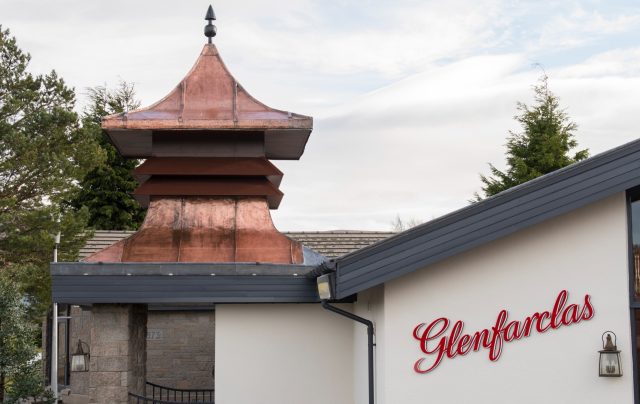
The two-day trip to Speyside, courtesy of the Glenfarclas Distillery, owned by J & G Grant, and guided by distillery manager Callum A Fraser, was filled with one highlight after another.
Nestled among the mountains next to the Ballindalloch Castle, located in Scotland’s renowned whisky region of Speyside, Glenfarclas is one of the few remaining family-owned distilleries from the 1800s. Now in its fifth generation of ownership by the Grant family, the distillery was established on the Recherlich farm. John Grant purchased it in 1865 for £511.19s from Robert Hay, who founded the site in 1836.
The distillery is renowned for its commitment to heritage. Described as ‘a traditional’ distillery, Glenfarclas, Gaelic for ‘Valley of the Green Grassland’, is one of the few Scottish whisky distilleries that still use direct gas-fired stills to produce unpeated whiskies, and maturing them predominantly in European oak oloroso Sherry casks.
Our journey at Glenfarclas began with a bumpy ride in four-wheelers, travelling across the Ballindalloch lands to the distillery’s water source in the windy cradle of Ben Rinnes. At the hillside, we were greeted by chef and MasterChef finalist Sarah Rankin, who had prepared canapés to accompany the flavours of Glenfarclas 12-year-old and 105.
The spring is situated on land owned by the Ballindalloch estate, which attempted to restrict Glenfarclas from accessing the water source after the First World War. However, an agreement established in 1930 permitted the distillery to collect as much water as it could through a pipe with an inner diameter of eight inches. This agreement is still in effect today and supplies all the water used in the production of Glenfarclas whiskies.
Unfortunately, the natural spring is inaccessible to most visitors, as it can only be reached by hiking through thick fields of heather and descending a few metres to reach the small pond. At the spring, we raised our glasses of Glenfarclas 105 to pay tribute to the birthplace of the distillery’s whiskies.
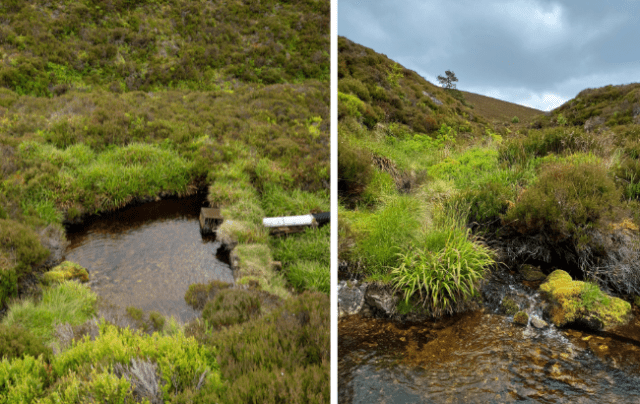
‘Swimming upstream’
The first thing that catches the eye at the distillery is the pagoda roof designed by Charles Doig in 1896, which serves as the entrance to the visitor centre. While it is now purely decorative, it was once functional at the distillery. Fraser, the distillery manager for the last 13 years, explained: “We stopped malting our own barley in 1972. Being family-owned, we don’t throw anything out, so we preserved the pagoda roof that used to be atop our malting building across the courtyard. When we opened the visitor centre in 1973, we made it the main entrance.”
Glenfarclas was one of the first distilleries in Scotland to open a dedicated centre for visitors. Today, the distillery offers four different experiences from a one-and-a-half-hour Classic Tour priced at £15 (US$20) per person to a three-hour-long 1950s Family Cask Experience, cleverly priced at £511.19 (US$687) per person.
The Glenfarclas Distillery is home to 44 dunnage-style warehouses, which have the combined capacity to mature around 105,000 casks of whisky at a time. These warehouses, adorned by distinctive poppy-red doors, currently contain approximately 103,000 barrels. The site is also home to ‘the world’s smallest warehouse’, housing two hogsheads and a Sherry butt. Over the years, the number of warehouses has increased, with new ones constructed in 2022 and the most recent completed earlier this year. Additionally, the distillery has secured a permit to build six more warehouses on the site, potentially raising the total number of maturing facilities to 50 with a capacity for 120,000 casks.
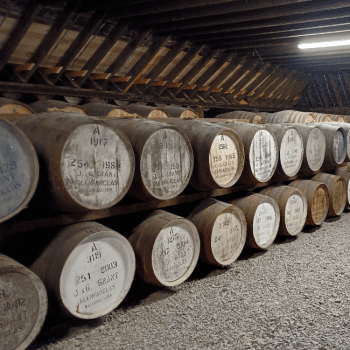
According to Fraser, the distillery has a history of increasing production during unexpected times. He explained: “We all know that the whisky industry is currently experiencing a significant downturn, so it may seem strange to be building more warehouses.
“We’re repeating a bit of history here. In 1881, when the industry faced a downturn, Glenfarclas doubled its production and constructed warehouses to keep production in. A similar approach was taken before the downturn in the 1980s when we expanded our stills from two to four in 1960 and then from four to six in 1976. As John (Grant, current chairman of Glenfarclas) notes in his book, ‘We swam upstream.’ Now, we’re doing it again, and we’ll benefit from that.”
The distillery has used Sherry casks from Bodega Jose y Miguel Martin in Jerez, Spain, since the 1980s. Before then, members of the Grant family sourced casks built for transporting Sherry from pubs, wine, and spirits merchants to do “them a favour”.
Glenfarclas invests approximately £3 million (US$4 million) annually in casks. The Sherry stays in the casks for at least three years, after which the vessels are emptied and filled with new make spirit at an ABV of 63.5%. On the morning of our visit, the distillery had filled 80 Sherry butts, each costing £1,900 (US$2,550).
In 2012-2013, the family invested around £1.7 million (US$2.3 million) to open a bio plant on the site to look after its waste water. As part of the distillery’s sustainability plan, in 2023, Glenfarclas installed solar panels on both sides of its mash roof to reduce its carbon footprint. This is part of a wider goal, with the Scotch whisky sector hoping to become carbon-negative by 2036.
Distillery tour

From the visitor centre, our journey took us to the old malting building, where malted barley is stored and prepared for mashing. Although grain fields surround the distillery, it does not use the local grain to make whisky. Glenfarclas Distillery can store 330 tonnes of malted barley at any given time and currently processes 66 tonnes per week. However, with increased production, it can handle up to 198 tonnes weekly.
In the mill room, we were greeted by a five-roller Swiss Buhler mill, which was imported to the site in 1975. The mill not only sieves and mills the barley, providing the distillery with precise control over the process, but also creates husk, grits, and flour in a ratio that enhances the yield during mashing. Additionally, it effectively removes unwanted materials, such as rocks, preventing them from entering the next production phase.
The mill can process eight tons of barley per hour and operates twice daily. It feeds into a semi-lauter mash tun with a capacity of 16.5 tons, the second largest in Speyside, boasting a diameter of 10 meters. The mashing process takes 11 hours, producing an average output of 6,888 pounds of alcohol per mash.
Since 2017, the walls around the distillery’s production area have featured the faces of its workers. Fraser emphasised the importance of the staff, and stated: “They are the most important people we have. Without them, we have nothing. You don’t have a distillery; you have nothing. These individuals are vital to our operations. There are those who cut the grass, sweep the yard, paint the walls, and even make whisky in their spare time. That’s the best way to describe them. Each person has a unique personality, and when we hire them, we do not just look at their skills; we hire them for what they can contribute.”
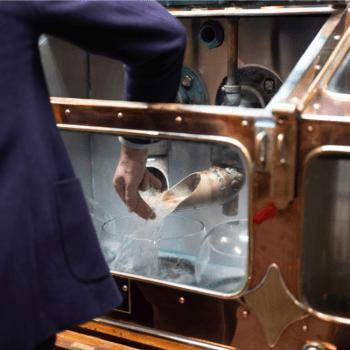
Next up are 12 stainless steel washbacks, where the mash is fermented for an average of 106 hours. The distillery only uses two fermenting washbacks at a time – while other distilleries only use one – with a maximum of 13 mashes a week.
The stillroom houses three pairs of Forsyths copper pot stills, which are directly fired. Glenfarclas has an annual production capacity of 3.5m litres, making it a medium-sized distillery in Scotland.
As a rare treat, Fraser unlocked the spirit safe to display the spirits’ character fresh from the still.
According to him, the traditional, directly fired stills are essential to the fruity character of Glenfarclas whisky. He explained: “Our process produces notes of green apples, mistletoe, and earthy flavours, all thanks to the direct fire stills. While a cooper may claim that 70% of the flavour in Scotch whisky comes from the cask they create, I would disagree. This is because by the time our spirit emerges from the stills, it already possesses digestive notes, fruity green apple flavours, and hints of coffee.”
Selecting casks
The selection of casks ready for bottling or vatting is entrusted to Fraser and the distillery’s managing director Douglas Belford. The whiskies are combined in the distillery’s vatting complex, which contains two vats of 12,500 litres each and two of 47,000 litres each. The only whiskies not included in this process are single cask bottlings, which are bottled individually. The team carefully monitors old casks to ensure that the alcohol level does not fall below 40% ABV and to determine the peak for bottling.
Each whisky is nosed, tasted, and checked for consistent colour by Fraser and Belford.
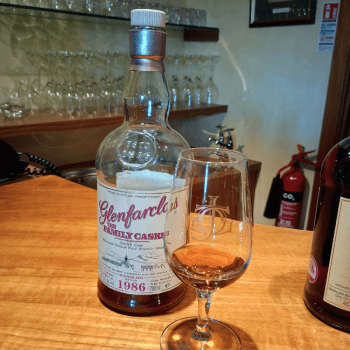
Fraser explained the process: “We consider whether it comes from a first, refill Sherry cask, a second or third fill to meet your expectations for the bottle. When consumers buy Glenfarclas, we aim for the whisky to be as consistent as possible. It’s a batch process. While you won’t get it exactly the same every time, it should be close enough to recognise it by the nose.”
He added: “We control everything as soon as the grain arrives here. We manage the mashing, distilling, and warehousing. It’s a very effective way to work.”
To conclude our informative distillery tour, we were treated to a selection of the Glenfarclas Family Cask bottlings, matched to each visitor by birth year. (When I told them I was born in 1953, just like another visitor, they didn’t believe me.)
As the cherry on top, our arrival at the hotel was greeted with a 2025 edition of Glenfarclas: An Independent Distillery by Ian Buxton, detailing the distillery’s 190-year history.
The main event
In the evening, we were joined by Glenfarclas Distillery chairman, John Grant, and escorted to warehouse number one for a special event: the unveiling of the distillery’s oldest expression to date, the 70-year-old single malt.
To start the historical event, Fraser asked everyone to stay silent. “One thing I want you to do before we talk about the new release is just stand and say nothing.” After a moment of silence, he continued: “For the past 70 years, the whisky has listened to that sound in this warehouse. It’s just sat and matured for 70 years with no noise, just aged to perfection.”

The whisky was distilled on 20 November 1953 using barley malted on site and spent its time in a single first-fill Sherry cask, in which, the Sherry was kept in for six to nine months before filled with new make. The whisky was drawn from one of the last remaining casks from the 1950s, looked after by six distillery managers in the dunnage warehouse.
And now the drum roll, please. With a ‘pop’, the first bottling of Glenfarclas 70-year-old single malt was opened, one of only 262 bottles.
The whisky invites in with aromas of stewed fruits and traditional Scottish dumpling with ‘a delicate thread of Speyside peat drawn from the slopes of Ben Rinnes’, which adds a lightly earthy, smoky nuance. The palate offers dark chocolate notes with Sherry-soaked dried fruits, roasted coffee, and treacle toffee.

The milestone expression, which retails for £20,000 (US$26,834), showcases the family-owned distillery’s dedication to tradition and expertise. Presented in the same Warehouse Collection box as the Glenfarclas 30 and 40-year-old, the 70-year-old continues the distillery’s approach of ‘taste over presentation’.
According to Fraser, a lot of discussion was had regarding the packaging of the release, as he explained: “After a lengthy discussion, we decided to keep it in the traditional family way that we do things. We keep it simple and as basic as we can, since the box gets thrown out anyway at the end. But what we want is for this liquid to speak for itself. The most important thing about the packaging is what’s inside that bottle.”
And that’s exactly what this release manages to achieve. After 70 years of maturation, the whisky stands out as a well-balanced expression with depth and complexity, displaying surprisingly fruity notes for the age, with a lovely smoky nuance not commonly associated with Glenfarclas. Not only a masterpiece of heritage and legacy, but an indulgent treat.
The indulgence at the warehouse continued with a dinner at the distillery visitor centre, prepared by chef Rankin. The meal was accompanied by a dram of Glenfarclas 21-year-old, and another pour of the 70-year-old, to put the cream on top of the cherry. I feel lucky to have been invited to be part of the distillery’s milestone celebration.
Related news
Cotswolds Distillery debuts Highgrove Evergreen whisky
Japan’s Shindo Distillery releases first whisky
Argentinian distillery bottles world’s first Antarctic-aged whisky
